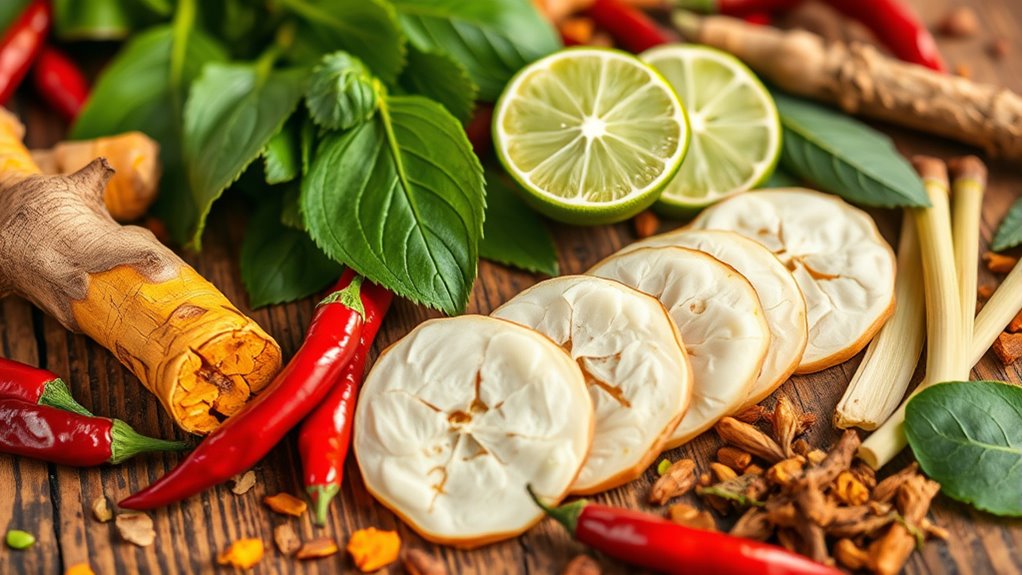From galangal to kaffir lime, Indonesian spices and herbs are essential for creating its vibrant flavors and rich cultural traditions. Galangal adds earthy, citrusy notes, while kaffir lime leaves bring bright aroma and freshness. These ingredients aren’t just for taste; they also carry medicinal qualities, like aiding digestion and promoting healing. Exploring these natural treasures reveals a deep connection between flavor and wellness that’s central to Indonesian cooking and healing practices. Keep exploring to discover more about these remarkable ingredients.
Key Takeaways
- Indonesian cuisine features key spices like turmeric, coriander, cumin, cloves, and nutmeg, forming foundational flavor blends such as “bumbu.”
- Herbs like galangal, lemongrass, turmeric, ginger, and kaffir lime leaves are valued for both culinary and medicinal purposes.
- Galangal and ginger are essential for their aromatic flavors and digestive health benefits in traditional dishes and remedies.
- Kaffir lime leaves contribute a distinctive citrus aroma, used in cooking and herbal teas for their therapeutic properties.
- These spices and herbs reflect Indonesia’s rich cultural heritage, blending culinary tradition with natural healing practices.

Indonesian spices and herbs are the heart of its rich culinary tradition, infusing dishes with bold flavors and vibrant aromas. When you explore Indonesian cuisine, you’ll quickly notice how essential spices are to creating the distinctive taste profiles that define regional dishes. These spices are often combined into traditional spice blends, which serve as the foundation for many recipes. For example, you might encounter a spice mix called “bumbu,” a complex blend of turmeric, coriander, cumin, cloves, and nutmeg, carefully prepared to add depth and warmth to stews, grilled meats, and soups. Such blends aren’t just culinary essentials—they also carry cultural significance, passed down through generations, preserving unique flavor profiles that reflect Indonesia’s diverse heritage.
Beyond their culinary uses, many Indonesian herbs and spices have a rich history of herbal medicinal uses. You might be surprised to learn that ingredients like turmeric and ginger aren’t just flavoring agents; they’re also valued for their health benefits. Turmeric, with its active compound curcumin, is renowned for its anti-inflammatory and antioxidant properties, making it a popular natural remedy for various ailments. Ginger, another staple, is used to soothe digestion and reduce nausea, often brewed into teas or mixed into traditional remedies. Lemongrass and kaffir lime leaves are also appreciated for their aromatic qualities and medicinal benefits, believed to help with digestion, respiratory issues, and even stress relief. These herbs are often incorporated into traditional herbal remedies, which are still used in rural communities today to maintain health and wellness.
Indonesian herbs like turmeric, ginger, lemongrass, and kaffir lime leaves are valued for their medicinal benefits and culinary uses.
You’ll find that many Indonesian spices are more than just flavor enhancers—they’re integral to holistic health practices. For instance, lemongrass is often boiled to make herbal teas believed to detoxify the body, while turmeric is applied topically or consumed in soups to promote healing. These herbal medicinal uses are deeply rooted in local culture, blending culinary tradition with natural healing. When you cook with Indonesian spices, you’re not just creating flavorful dishes—you’re participating in a centuries-old tradition of using herbs for their therapeutic qualities. This dual purpose of spices and herbs underscores their importance in Indonesian society, where food and medicine often overlap.
Additionally, understanding the regulatory frameworks surrounding the use of herbal remedies can be beneficial for those interested in integrating traditional practices with modern health approaches.
In essence, Indonesian spices and herbs serve as both flavor catalysts and natural remedies. Their traditional spice blends encapsulate the rich culinary diversity of the archipelago, while their herbal medicinal uses reflect a profound understanding of nature’s healing potential. By embracing these ingredients, you connect with Indonesia’s vibrant cultural tapestry, experiencing its flavor and wellness traditions firsthand.
Frequently Asked Questions
How Do Indonesian Spices Influence Global Culinary Trends?
Indonesian spices influence global culinary trends by enriching fusion cuisine with bold, complex flavor profiles. You’ll notice dishes worldwide incorporating ingredients like galangal, kaffir lime, and turmeric, creating vibrant and aromatic flavors. These spices inspire chefs to experiment, blending traditional Indonesian elements with other cuisines, leading to innovative dishes. Their unique taste elevates global menus, making Indonesian culinary influence a crucial part of contemporary food trends.
Are There Any Health Benefits Associated With Indonesian Herbs?
You’ll find Indonesian herbs offer notable health benefits through their herbal medicinal properties and antioxidant effects. These herbs help boost your immune system, reduce inflammation, and fight oxidative stress. By incorporating ingredients like turmeric, lemongrass, and kaffir lime into your meals, you enhance not only flavor but also your well-being. Their natural compounds support your health, making every dish a flavorful step toward better vigor.
How Are These Spices Traditionally Harvested and Processed?
You start with traditional harvesting methods, carefully plucking herbs like basil or spices like turmeric at peak ripeness to guarantee flavor and potency. Then, you use traditional processing techniques such as sun-drying, pounding, or fermenting to preserve the herbs and enhance their flavors. These methods maintain the authenticity and quality of Indonesian spices, allowing you to enjoy their rich aroma and health benefits in your cooking.
Can Indonesian Spices Be Grown Outside Southeast Asia?
You can grow Indonesian spices outside Southeast Asia, but it’s not a walk in the park; climate adaptability and cultivation challenges are key. These spices thrive in tropical, humid environments, so you’ll need to mimic those conditions closely. In temperate zones, you’ll face hurdles like cold temperatures and shorter growing seasons. With proper care, greenhouse setups, or indoor gardening, you might just beat the odds and enjoy these flavors locally.
What Are Some Common Substitutions for Hard-To-Find Indonesian Spices?
If you can’t find Indonesian spices, you can use substitute dried herbs like lemongrass powder or galangal paste for fresh galangal. Alternative spice blends, such as Thai or Malaysian mixes, often contain similar flavors and work well in recipes. Don’t hesitate to experiment with these options to achieve authentic taste, and adjust quantities to suit your preference. This way, your dishes stay flavorful even without the original spices.
Conclusion
Now that you know about galangal, kaffir lime, and other essential Indonesian spices and herbs, you can elevate your cooking with authentic flavors. Embrace the vibrant aromas, explore the bold tastes, and experiment with these ingredients in your dishes. Whether you’re seasoning, garnishing, or simmering, let these spices inspire you to create rich, flavorful meals. Discover, experiment, and enjoy—the essence of Indonesian cuisine is at your fingertips.









